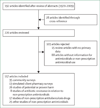Non-prescription antimicrobial use worldwide: a systematic review
- PMID: 21659004
- PMCID: PMC3543997
- DOI: 10.1016/S1473-3099(11)70054-8
Non-prescription antimicrobial use worldwide: a systematic review
Abstract
In much of the world antimicrobial drugs are sold without prescription or oversight by health-care professionals. The scale and effect of this practice is unknown. We systematically reviewed published works about non-prescription antimicrobials from 1970-2009, identifying 117 relevant articles. 35 community surveys from five continents showed that non-prescription use occurred worldwide and accounted for 19-100% of antimicrobial use outside of northern Europe and North America. Safety issues associated with non-prescription use included adverse drug reactions and masking of underlying infectious processes. Non-prescription use was common for non-bacterial disease, and antituberculosis drugs were available in many areas. Antimicrobial-resistant bacteria are common in communities with frequent non-prescription use. In a few settings, control efforts that included regulation decreased antimicrobial use and resistance. Non-prescription antimicrobial and antituberculosis use is common outside of North America and northern Europe and must be accounted for in public health efforts to reduce antimicrobial resistance.
Copyright © 2011 Elsevier Ltd. All rights reserved.
Conflict of interest statement
DM and SW have received unrestricted research grants from Merck. ENP has received unrestricted research grants from Merck and Pfizer. INO and RL declare no conflicts of interest.
Figures


Comment in
-
Antibiotics obtained without a prescription in Europe.Lancet Infect Dis. 2012 Mar;12(3):182-3. doi: 10.1016/S1473-3099(12)70017-8. Lancet Infect Dis. 2012. PMID: 22361429 No abstract available.
References
-
- Col NF, O’Connor RW. Estimating worldwide current antibiotic usage: report of task force 1. Rev Infect Dis. 1987;9(suppl 3):232–243. - PubMed
-
- WHO. The global burden of disease: 2004 Update. Geneva: World Health Organization; 2008.
-
- Boucher HW, Talbot GH, Bradley JS, et al. Bad bugs, no drugs: No ESKAPE! An update from the Infectious Diseases Society of America. Clin Infect Dis. 2009;48:1–12. - PubMed
-
- Spellberg B, Guidos R, Gilbert D, et al. The epidemic of antibiotic-resistant infections: A call to action for the medical community from the Infectious Diseases Society of America. Clin Infect Dis. 2008;46:155–164. - PubMed
-
- Taubes G. The bacteria fi ght back. Science. 2008;321:356–361. - PubMed
Publication types
MeSH terms
Substances
Grants and funding
LinkOut - more resources
Full Text Sources
Medical

